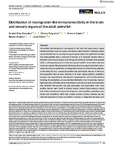Distribution of Neurogranin-Like Immunoreactivity in the Brain and Sensory Organs of the Adult Zebrafish

Use this link to cite
http://hdl.handle.net/2183/31022
Except where otherwise noted, this item's license is described as Atribución-NoComercial-SinDerivadas 4.0 Internacional
Collections
- Investigación (FCIE) [1228]
Metadata
Show full item recordTitle
Distribution of Neurogranin-Like Immunoreactivity in the Brain and Sensory Organs of the Adult ZebrafishDate
2022-01-11Citation
Alba-González, A., Folgueira, M., Castro, A., Anadón, R., & Yáñez, J. (2022). Distribution of neurogranin-like immunoreactivity in the brain and sensory organs of the adult zebrafish. J Comp Neurol. 530, 1569– 1587. https://doi.org/10.1002/cne.25297
Abstract
[Abstract] We studied the expression of neurogranin in the brain and some sensory organs (barbel taste buds, olfactory organs, and retina) of adult zebrafish. Database analysis shows zebrafish has two paralog neurogranin genes (nrgna and nrgnb) that translate into three peptides with a conserved IQ domain, as in mammals. Western blots of zebrafish brain extracts using an anti-neurogranin antiserum revealed three separate bands, confirming the presence of three neurogranin peptides. Immunohistochemistry shows neurogranin-like expression in the brain and sensory organs (taste buds, neuromasts and olfactory epithelium), not being able to discern its three different peptides. In the retina, the most conspicuous positive cells were bipolar neurons. In the brain, immunopositive neurons were observed in all major regions (pallium, subpallium, preoptic area, hypothalamus, diencephalon, mesencephalon and rhombencephalon, including the cerebellum), a more extended distribution than in mammals. Interestingly, dendrites, cell bodies and axon terminals of some neurons were immunopositive, thus zebrafish neurogranins may play presynaptic and postsynaptic roles. Most positive neurons were found in primary sensory centers (viscerosensory column and medial octavolateral nucleus) and integrative centers (pallium, subpallium, optic tectum and cerebellum), which have complex synaptic circuitry. However, we also observed expression in areas not related to sensory or integrative functions, such as in cerebrospinal fluid-contacting cells associated with the hypothalamic recesses, which exhibited high neurogranin-like immunoreactivity. Together, these results reveal important differences with the patterns reported in mammals, suggesting divergent evolution from the common ancestor.
Keywords
Danio rerio
Neurogranin
Protein kinase C
RC3
Teleost
Zebrafish
Neurogranin
Protein kinase C
RC3
Teleost
Zebrafish
Editor version
Rights
Atribución-NoComercial-SinDerivadas 4.0 Internacional
ISSN
1096-9861






